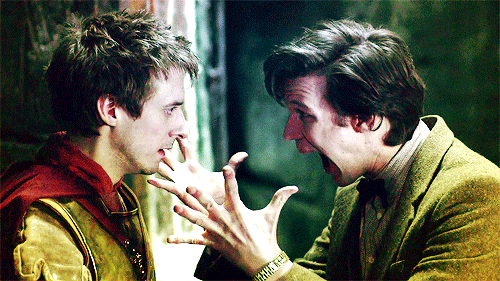Zachary Tringali's Blog, page 3
June 17, 2013
If I Stay by Gayle Forman
Su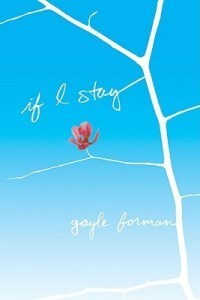 m it up: Told primarily through flashbacks, If I Stay takes place in the wake of a car accident that kills Mia’s entirely family and leaves her in a coma. She could still wake up, but the question is, does she want to?
m it up: Told primarily through flashbacks, If I Stay takes place in the wake of a car accident that kills Mia’s entirely family and leaves her in a coma. She could still wake up, but the question is, does she want to?
Thoughts: Okay. I know what you’re thinking. I thought it too. If I Stay could so easily be a book that rests on the depressing nature of its premise. You instantly picture a lot of “Oh, what’s the point of even going on?” set to a soundtrack of Dashboard Confessional.
Do people still know who Dashboard Confessional is anymore, even?
Anyway. The book could have easily become mired in a kind of sad sentimentality, creating a shallow experience, but If I Stay manages to avoid this pitfall at every turn. Gayle Forman uses flashbacks to masterfully pull the heartstrings by focusing on the good things in life rather than the bad, providing a contrast that has you smiling only to one minute later be crushed by the reality of the situation.
And if you’re like me you’re also wondering how you write an entire book based on this one question with a character unable to interact with anyone around her. Forman does it. I’ll say something else, too: she does it in the perfect amount of words. I was skeptical about being able to carry this point for its 250+ pages and figured it’d end up getting tiring more than anything else.
But I cracked open the book to read a few pages and ended up reading the entire thing in one sitting. So, there you have it.
I know at this point I’m gushing, so let me wrap up by saying: read this book. Does it fumble once in a while? Sure. There are one or two scenes I can think of that felt a little forced, but at its core the book is solid. It’s more than solid, and whatever missteps it took were brief and quickly corrected.
If you liked this book: Despite an entirely different subject matter, the book that most reminds me of If I Stay would have to be Lola and the Boy Next Door by Stephanie Perkins, because they both have strong characters and a lot of heart.


June 3, 2013
Book Talk: Making History in Fiction, and reading Daggerspell
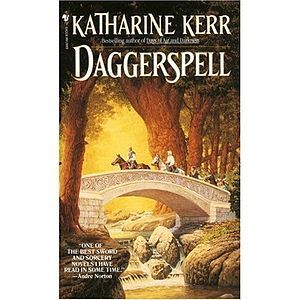 About a month ago I picked up a copy of Katharine Kerr’s Daggerspell from the local bookstore. I’d never heard of it before, but it seemed like a good old fashioned sword and sorcery book, and I’d been looking for something like that. Something simple, I thought, and fun.
About a month ago I picked up a copy of Katharine Kerr’s Daggerspell from the local bookstore. I’d never heard of it before, but it seemed like a good old fashioned sword and sorcery book, and I’d been looking for something like that. Something simple, I thought, and fun.
Boy, was I wrong. Well, about it being simple, anyway.
After working through some more of my backlog, I finally picked the book up to read the other day. What I found out was that Daggerspell is a criminally underrated classic of the genre that has to be one of the best examples of organic world building I’ve ever seen. With a story based around rebirth through countless generations, Kerr is able to create a history in her books that feels very organic. You see a world evolve over time in a way I really haven’t seen any other book do, and it’s fascinating and great.
So much of good world building in fantasy seems to come down to knowing where things came from. The history that led to whatever sets a fantasy world apart from the normal world, and creating a story that lets you feel attached to these historical things is just an incredibly cool way of bringing you into the story.
I’m also really liking that, while bigger things are obviously afoot (I’m only about three-quarters of the way through now), and it’s a story told across a very long period of time, it remains a very close, personal story. It’s about characters and relationships and change as much as it’s about wars and magic and things.
At the end of the day, that’s my favorite kind of fantasy to read–the kind that uses the trappings of the genre to give you a really good story about characters. The kind of stories you just can’t get in genres more heavily steeped in needing to stick to the rules of our own world.
So, I didn’t get the book I expected to get, I ended up getting something much better.


Making History in Fiction, and reading Daggerspell
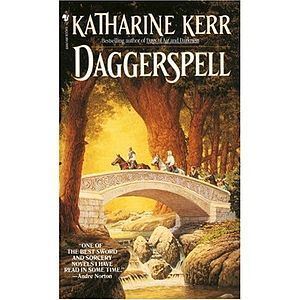 About a month ago I picked up a copy of Katharine Kerr’s Daggerspell from the local bookstore. I’d never heard of it before, but it seemed like a good old fashioned sword and sorcery book, and I’d been looking for something like that. Something simple, I thought, and fun.
About a month ago I picked up a copy of Katharine Kerr’s Daggerspell from the local bookstore. I’d never heard of it before, but it seemed like a good old fashioned sword and sorcery book, and I’d been looking for something like that. Something simple, I thought, and fun.
Boy, was I wrong. Well, about it being simple, anyway.
After working through some more of my backlog, I finally picked the book up to read the other day. What I found out was that Daggerspell is a criminally underrated classic of the genre that has to be one of the best examples of organic world building I’ve ever seen. With a story based around rebirth through countless generations, Kerr is able to create a history in her books that feels very organic. You see a world evolve over time in a way I really haven’t seen any other book do, and it’s fascinating and great.
So much of good world building in fantasy seems to come down to knowing where things came from. The history that led to whatever sets a fantasy world apart from the normal world, and creating a story that lets you feel attached to these historical things is just an incredibly cool way of bringing you into the story.
I’m also really liking that, while bigger things are obviously afoot (I’m only about three-quarters of the way through now), and it’s a story told across a very long period of time, it remains a very close, personal story. It’s about characters and relationships and change as much as it’s about wars and magic and things.
At the end of the day, that’s my favorite kind of fantasy to read–the kind that uses the trappings of the genre to give you a really good story about characters. The kind of stories you just can’t get in genres more heavily steeped in needing to stick to the rules of our own world.
So, I didn’t get the book I expected to get, I ended up getting something much better.


May 7, 2013
Book Talk: Same Story, Different Telling — Arthurian Legend and other Stories
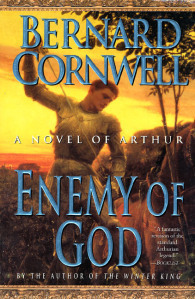 So, I haven’t done a Friday Reads post in a while, unfortunately.
So, I haven’t done a Friday Reads post in a while, unfortunately.
But I’ve just been burning through books based on Arthurian month for the past month or more. From the slightly more fantastical Hawk of May (and its sequel Kingdom of Summer) by Gillian Brashaw to the exceptionally realized Warlord Chronicles by Bernard Cornwell.
I’ve posted before about how throughout time we reinvent and reimagine stories and create deeper worlds. We take these classic stories that we love and we can’t help but keep telling stories about them, hundreds and hundreds of years after their inception.
I’d expected a certain amount of diminishing returns after finishing a ton of Arthur tales in a row. I mean, you can only read about a guy accidentally sleeping with his step-sister or pulling a sword from a stone so many times, right? But to my surprise, I haven’t gotten tired of the story yet. Reading several tellings in a row, the myths become a sort of framing device telling a familiar story on which all the details can be hung.
It reminds me of comic books. We go through endless cycles of characters–dying, being reborn, suffering, rejoicing. Everything stays the same, except the lens we view it through, provided by the author. It keeps these stories and characters alive, and it creates an incredibly vivid picture of a character or characters that we can see from multiple angles and points of view.
Even if sometimes you don’t agree with the route taken for characters in these retellings, it always, always gives you something to think about. It’s that what if that’s addicting–the what if that you look for in any good book.
I’m on the second book of the Warlord Chronicles (Enemy of God) by Bernard Cornwell, now. As anyone who knows me can tell you, I’m a huge fan of Cornwell, and his Arthur books might be some of my favorite novels from him so far–possibly even my favorite books about Arthur as well.
Cornwell takes a character we all know from the stories, a man that has become a legend and an archetype all in his own, and he turns him–pinocchio-like–into a real, living man. He’s still a just, honest man dedicated to what he believes to be a true path, but he’s also a warrior (with all of the anger issues that entails), and a conflicted man living in hard times. He’s not especially good looking, but he’s charming. He’s real.
So, what do you guys say. Are there any stories you can’t help but read every possible retelling of? Any mythos you have a particular weakness for?


Same Story, Different Telling — Arthurian Legend and other Stories
 So, I haven’t done a Friday Reads post in a while, unfortunately.
So, I haven’t done a Friday Reads post in a while, unfortunately.
But I’ve just been burning through books based on Arthurian month for the past month or more. From the slightly more fantastical Hawk of May (and its sequel Kingdom of Summer) by Gillian Brashaw to the exceptionally realized Warlord Chronicles by Bernard Cornwell.
I’ve posted before about how throughout time we reinvent and reimagine stories and create deeper worlds. We take these classic stories that we love and we can’t help but keep telling stories about them, hundreds and hundreds of years after their inception.
I’d expected a certain amount of diminishing returns after finishing a ton of Arthur tales in a row. I mean, you can only read about a guy accidentally sleeping with his step-sister or pulling a sword from a stone so many times, right? But to my surprise, I haven’t gotten tired of the story yet. Reading several tellings in a row, the myths become a sort of framing device telling a familiar story on which all the details can be hung.
It reminds me of comic books. We go through endless cycles of characters–dying, being reborn, suffering, rejoicing. Everything stays the same, except the lens we view it through, provided by the author. It keeps these stories and characters alive, and it creates an incredibly vivid picture of a character or characters that we can see from multiple angles and points of view.
Even if sometimes you don’t agree with the route taken for characters in these retellings, it always, always gives you something to think about. It’s that what if that’s addicting–the what if that you look for in any good book.
I’m on the second book of the Warlord Chronicles (Enemy of God) by Bernard Cornwell, now. As anyone who knows me can tell you, I’m a huge fan of Cornwell, and his Arthur books might be some of my favorite novels from him so far–possibly even my favorite books about Arthur as well.
Cornwell takes a character we all know from the stories, a man that has become a legend and an archetype all in his own, and he turns him–pinocchio-like–into a real, living man. He’s still a just, honest man dedicated to what he believes to be a true path, but he’s also a warrior (with all of the anger issues that entails), and a conflicted man living in hard times. He’s not especially good looking, but he’s charming. He’s real.
So, what do you guys say. Are there any stories you can’t help but read every possible retelling of? Any mythos you have a particular weakness for?


April 1, 2013
When Stories in Games Work: Bioshock Infinite
 I haven’t been playing a lot of games lately, mostly due to a lack of time but also because I’ve had a harder time finding things I’ve been interested in sinking a good amount of time into. At last, as far as narrative games go–the majority of “game time” I have these days ends up going towards online games where I can mostly tune out the narrative and just focus on having fun with friends.
I haven’t been playing a lot of games lately, mostly due to a lack of time but also because I’ve had a harder time finding things I’ve been interested in sinking a good amount of time into. At last, as far as narrative games go–the majority of “game time” I have these days ends up going towards online games where I can mostly tune out the narrative and just focus on having fun with friends.
I don’t know when it happened, but lately whenever I pick up a single player game, the cutscenes seem to drag on and I’m stuck sifting through text waiting for the actual game to start, feeling like I’m wasting time I could be doing other things.
So when I picked up Bioshock: Infinite on a whim and was immediately hooked, I started to wonder why. Why did the narrative immediately engage me, why was I able to just get involved in it without all of the usual rigmarole?
For starters, beyond a certain minimal set up, the game just drops you into the story in a way that I found instantly compelling. Secondly, everything in the game tells a story. From the visual trappings to the audio you hear around you–the people talking, the radios.
But the real reason that all works is because the game doesn’t stop you in your tracks and try to explain it to you. It lets that go on in the background and trusts you to pick up on it. The experience is as deep or as shallow as you want, which ends up making you want to hunt out the information to figure out exactly what’s going on.
It doesn’t hurt that Infinite develops one of the better secondary characters I’ve seen in games in a long time. Most of the time, companions in games either fade into the background or become a hindrance, needing your protection without giving much in return.
Elizabeth, your companion in the game, is not only able to completely take care of herself,
but she’s an interesting character with a strong personality. When she talks, you want to stop for a minute and here what she’s talking about. She’s been through a lot before you ever ran into her in the game, and it shows in the dialogue they’ve written for her.
That said, none of that information is forced on you. It never feels like you’re having to sift through a giant tome of information to get to the game. The setting and the characters are richly detailed, and you’re left with the freedom of exploring that as much as you like.
When I think about games as a medium to tell stories, I try to think of what advantage they have over something like a book or even a movie. The biggest boon to games as stories, in my opinion, is the ability to develop a world without forcing it on the person experiencing the story.
In a book and even in a movie, most of the time if the writer wants someone to know something, you have to try to find ways to weasel in the information or you end up dropping a huge information bomb. No one appreciates those from a storytelling element, even if they like the information being presented. It takes you out of the flow and reminds you that you’re just reading or watching something.
Games, on the other hand, have a better way of dealing with it. They can put the information out there and allow you to consume as much or as little of it as you like, whenever you like throughout the story. Infinite grabs hold of that concept and really puts it to good use.
There’s a whole host of other things I enjoy about the game, from the art to the setting, but the characters and the depth are the things that shine out the most to me. Other games may have had better stories, but Infinite makes a case for how well deep, rich stories in games can be conveyed, and reminded me of what the medium can do.


March 11, 2013
Stories Within Stories: INCEPTION’D
A friend of mine linked me to Mike DiMartino’s blog about stories the other day, and so I’ve been browsing through a little each night, reading old entries and thinking about stories and what they mean to people and how we build them.
Last weekend my girlfriend and I went down to Orlando to visit friends and see Wicked (which was great), and that got me thinking about stories again. What it really got me thinking about was historical fiction and retellings, actually.
Retellings and unofficial sequels are really popular right now–you don’t need to look further than searching for “Mr. Darcy …” at the bookstore and you’ll find a bunch–to say nothing about the popularity of fairy tales being retold now. (Cast in point: I just finished watching Once Upon a Time. Any other watchers want to rage with me? Gah.)
Anyway, I remember reading an interview with a historical fiction writer a while back now, and I can’t remember who it was unfortunately, but they said that there favorite thing about the genre was finding the gaps in events that happened and coming up with all of the things that could have fit in those spaces.
Wicked made me think of that. We know a lot of stories about Oz, but someone saw space where a story could be told about the wicked witch and it got their mind turning. The same way historical fiction writers see two points in history and their brains are suddenly filled with what could have happened between two points. I mean, fan fiction writers do the same thing a lot of times.
Taking this back a step, culturally everyone does this. We love rumors, because it inserts a story between things we know that collects these nodes in our brains like lightning bolts. We know point A and point C, but throwing in this idea of B that connects the two is like bottled lightning.
It’s a way to take old stories that we know we love and reinvent them, Or to step back in time and breathe new life into an old story, just enough familiar touchstones that we’re in that comfort zone of the familiar, but the story teller stretches the boundaries and allows us, in the case of retellings, to experience something we love again for the first time or, in the case of historical fiction, to step back in time.
I love those simple What If questions that pull these stories back from the past and into the present. It keeps myths relevant, it brings history forward and puts us in touch with some of the oldest stories and ideas.
And it’s just incredibly cool.


March 7, 2013
Guest Blog: The Reinvention of Myth, by debut author Amalia Dillin
From deep within the dangerous Edit Mines, a wild blogger cries out! Okay, maybe that was a bit dramatic, but I’ve been buried under work-work and edits lately. BUT, today I have a VERY exciting post–a guest post! From a published author! And friend and critique partner! The ever talented Amalia Dillin.
Amalia’s first book, Forged by Fate, just came out earlier this week and is already getting excellent (and well deserved) reviews from all over the ‘Net. More on that later.
Without further ado…
The ReInvention of Myth
Every hardcore fantasy reader knows that Tolkien built The Lord of the Rings from mythology. Norse mythology, in particular, but not alone. Elves and Orcs, Dragons and Dwarves, Heroes who are not quite exactly mortal. He made these ideas, these characters and settings familiar to us, and built an entire genre from four well-loved books, and a couple less well-loved tomes. But he wasn’t the only one to recreate mythology in a way that brought it into popular culture – Superman, Batman, Thor, Captain America, even Spider-man are all part of this same evolution of mythology.
We see it most directly with Thor, of course, because Thor is still Thor, and Asgard is still Asgard, filled with the rest of the Norse pantheon – Baldur, Odin, Sif, Frigg, Loki. But Superman is built from Hercules and Samson, Captain America could just as easily be any other local cult hero of mythology – maybe Theseus, beloved example of everything that makes Athens great. Spider-man’s origin might be compared to someone like Arachne, cursed by the Athena and turned into a spider, and Batman – Batman is definitely an Odysseus, crafty and depending on his wits as much as his other strengths.
The retellings and references can be direct (Thor, Hercules, and Ares in Marvel comics, Wonder Woman and her Amazons in DC) or oblique (Batman’s dark path, fueled by a need to punish the criminals who murdered his parents is very reminiscent of the motivations which drive Orestes after Agamemnon’s murder), but they’re twined so thickly and so inextricably through the stories of our modern heroes that we often don’t even recognize it anymore. So we get graphic novels like 300, and the Marvel illustrated Trojan War stories – retellings of stories already being retold in the same medium, with a more literal approach. We root for Odysseus to find his way home the same way we read issue after issue while Batman hopscotched through time, struggling to return to the present – or for that matter, read issue after issue hoping that one day Bruce Wayne will finally find some kind of peace (I’m not holding my breath). And we read 300 – or watch the movie! – BELIEVING that the Spartans can hold the Persians off, and would have succeeded in destroying anything that was sent against them, too, if they hadn’t been betrayed!
But there’s a reason these stories are told and reinvented and told again, and resurrected. The themes are timeless. The need to believe in heroes and the triumph of the human spirit against any and all comers – against even the divine – gives us a sense that we have some control over the world we live in, we aren’t just at the mercy of all the suffering that surrounds us. We can take action. We have agency. There is hope.
So what does this have to do with FORGED BY FATE? Well, comic books are America’s mythology, Lord of the Rings was written for Britain, and Forged by Fate is my retelling of the history of the world, from creation to the present day, rebuilding it not just with the stories of one mythology, but with ALL of them. Because all those gods and goddesses – all those myths – they’re even MORE fun if they’re all real.
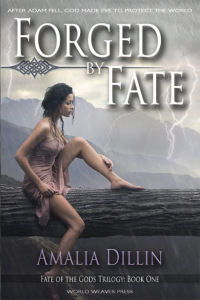 After Adam fell, God made Eve to protect the world.
— Adam has pursued Eve since the dawn of creation, intent on using her power to create a new world and make himself its God. Throughout history, Eve has thwarted him, determined to protect the world and all of creation. Unknown to her, the Norse god Thor has been sent by the Council of Gods to keep her from Adam’s influence, and more, to protect the interests of the gods themselves. But this time, Adam is after something more than just Eve’s power — he desires her too, body and soul, even if it means the destruction of the world. Eve cannot allow it, but as one generation melds into the next, she begins to wonder if Adam might be a man she could love.
After Adam fell, God made Eve to protect the world.
— Adam has pursued Eve since the dawn of creation, intent on using her power to create a new world and make himself its God. Throughout history, Eve has thwarted him, determined to protect the world and all of creation. Unknown to her, the Norse god Thor has been sent by the Council of Gods to keep her from Adam’s influence, and more, to protect the interests of the gods themselves. But this time, Adam is after something more than just Eve’s power — he desires her too, body and soul, even if it means the destruction of the world. Eve cannot allow it, but as one generation melds into the next, she begins to wonder if Adam might be a man she could love.
Forged by Fate available now, from World Weaver Press!
You can also purchase Forged by Fate on Amazon! Either in paperback or kindle. Or both!


February 22, 2013
The Big Cover Reveal: Forged by Fate
Today on the blog we have something SPECIAL! Friend and critique partner Amalia Dillin has been working hard getting ready for the launch of her debut novel, Forged by Fate, and today I’m happy to get to share the reveal of the COVER ART!
 Tell me THAT doesn’t strike a mood! World Weaver Press has done some great cover art for their books, but I think they knocked it out of the park with this one. Not to mention that tag line!
Tell me THAT doesn’t strike a mood! World Weaver Press has done some great cover art for their books, but I think they knocked it out of the park with this one. Not to mention that tag line!
You want to hear a little more about Forged by Fate now that you’ve been ENRAPTURED by that totally awesome cover art? Well, look no further, we’ve got a description for you right here:
After Adam fell, God made Eve to protect the world. — Adam has pursued Eve since the dawn of creation, intent on using her power to create a new world and make himself its God. Throughout history, Eve has thwarted him, determined to protect the world and all of creation. Unknown to her, the Norse god Thor has been sent by the Council of Gods to keep her from Adam’s influence, and more, to protect the interests of the gods themselves. But this time, Adam is after something more than just Eve’s power — he desires her too, body and soul, even if it means the destruction of the world. Eve cannot allow it, but as one generation melds into the next, she begins to wonder if Adam might be a man she could love.
Every god, from each of the world’s pantheons, mythologies, and religions — they’re all real in this enthralling fantasy romance that spans centuries.
Mythology, fantasy, romance, Forged by Fate has a bit of EVERYTHING and you’ll be missing out if you don’t check it out! Go ahead and add it to your GoodReads Want-to-Read List so you remember it on its release date, MARCH 5th, 2013. That’s LESS THAN TWO WEEKS AWAY! I am excited. So excited, I must use gifs.
I am not a man who gifs lightly. This is truly an awesome book! Be sure to keep an eye on the publisher, World Weaver Press, for information on where to buy the book upon release!


February 20, 2013
Back into the pit
Well.
I’m descending deep into the belly of the editing cave again. Draft three!
Confession time: I used to hate editing. I think it was all of the back tracking, the looking at things I wrote in the glaring light of day. I’d have much rather started another project or done… pretty much anything else.
But that’s changed. A lot of times editing is really work–or, it feels more like work than that first draft. That first draft is all fire and bluster, and the end product isn’t usually like what you had in mind. The second (and third and fourth and however many) drafts are where it starts to turn into the thing you always knew it was.
So, I’m excited. And nervous. But I’m working. I’m writing down new words and I’m editing old ones.
And in the meantime, I’m stopping here to share some music with you! Every time I work on a new project, there tends to be one song (or album) that I latch onto, that becomes synonymous with the project for me. Here’s one of the few for this one.


Zachary Tringali's Blog
- Zachary Tringali's profile
- 11 followers



